
MAY CONTAIN NUTS

Search Shorpy
SHORPY ART

Framed or unframed, desk size to sofa size, printed by us in Arizona and Alabama since 2007. Explore now.
Join and Share
Ad-Free Shorpy
Shorpy is funded by you. Patreon contributors get an ad-free experience.
Learn more.

Recent comments
- Robie House Roof(s)
- There is an interesting novel set here.
- I Was In Berlin
- Pronunciation
- Shell of a Shell
- Never been there but
- BUR-lin
- Hand-made smokes
- Birthplace of Tupperware, or at least its inventor
- Pulp
- Remarkably unchanged in 84 years
- The church is still there ...
- Talk about a smoke show
- Electric Hansom Cab
- I wondered the same thing.
- The location in 2009
- Pill Pusher
- Roll your own
- Rugged and real!
- Civil War history
- Early EV?
- A Charles Purcell - Mama Cass Connection
- Uncle SAAM
- Obfuscation
- One Chocolate Soldier rode away
- Victor Marquis de la Roche
- The Little House Across Way ...
- Vanderbilt Gates
- Vanderbilt Mansion
- You can still see that gate
Member Photos
The Shorpy
Printporium
Printporium
Search Shorpy
Search results -- 30 results per page
- Auto Wreck: 1923
- ... to be a novelty salesman, and stopping at the Sterling hotel, but according to the police, also rooming at the Harvard street address, ... Posted by Dave - 03/13/2014 - 10:00am -
![Auto Wreck: 1923 A larger, more detailed version of a photo we first posted six years ago, with the details supplied by Shorpy member Stanton Square, accompanied by a "new" image here.
Washington, D.C. A curious photograph titled "Auto wreck. 7/30/23." National Photo Company Collection glass negative. View full size.
1923 WreckI have seen this photograph published before, in a book by Robert Reed. Unfortunately, I can't for the life of me remember the title. Perhaps someone here knows what I'm writing about?
Rock Creek ParkwayThat was the year construction started on Rock Creek Parkway, and the water suggests that this car strayed off the parkway a bit.
[That, and the three trees he knocked over on the way in. Would be interesting to see if someone near Rock Creek Park could locate the spot. - Dave]
Chain Bridge WreckI've been searching the Washington Post archives trying to find the back-stories for some of the photographs on Shorpy. See, for example,
https://www.shorpy.com/node/3318
https://www.shorpy.com/node/3152
https://www.shorpy.com/node/2706
I've found an account of a July 30, 1923, wreck at Chain Bridge whose description seems to fit this photo. The story is surprisingly familiar - young kids party all night, wreck the car and then tell a fanciful story to the investigating police
-------------------------------------
Washington Post: July 31, 1923
Plunge Over Bank at Chain Bridge in Auto May be Fatal
Mrs. Dorothy Holland, 20 years old, of Baltimore, Md., stopping at 1420 Harvard street northwest, lies in Georgetown University Hospital suffering from internal hemorrhages as a result of an automobile in which she was riding going over a 30-foot embankment near the Virginia end of the Chain bridge at 6 o'clock yesterday morning.
Detective Sergeants H.M. Jett and Joseph Connors worked on the case more then fifteen hours in establishing the woman's real identity. Physicians at the hospital hold little hope for Mrs. Holland's recovery. Her sister, Mrs Myrtle Griffith, 1602 Gorsuch avenue, Baltimore, was summoned here last night by the local authorities.
When the machine, a touring car, traveling at an estimated 70 miles an hour going in the direction of Virginia, left the road and crashing through a fence dropped to the jagged rocks below three other persons were in the car besides Mrs. Holland. Two escaped with minor injuries while the driver of the machine, whose identity the police have been unable to establish, escaped injury. The other occupants of the machine were Mrs. Edna Metos, 24 years old, with whom Mrs. Holland stopped, and Bernard Shrove, of 56 Foxhall road, northwest. Mrs. Metos, was injured about the head and suffered shock. Shreve suffered a sprained ankle.
While police believe that Mrs. Metos was driving the machine at the time of the accident, both she and Mrs. Holland declare that a man whose name they do not know was the operator of the machine.
According to the police, the accident was the result of an all-night party that began at 1 o'clock yesterday morning. It was learned that the party went to the vicinity of the Chain bridge and were sitting on the bridge listening to music from a nearby camp.
Frank Haggerty, said to be a novelty salesman, and stopping at the Sterling hotel, but according to the police, also rooming at the Harvard street address, one of the party, left the machine when Shreve crossed the bridge riding a bicycle.
Haggerty, according to Shreve, asked him to let him ride the bicycle. When Haggerty started riding toward the District side of the bridge, Shreve said that the woman invited him to take a ride. They got in the machine and after going to the District side double back on their tracks and, traveling at a terrific rate of speed, started toward Virginia.
Shreve told Detectives Jett and Connors that a woman was driving the machine when it crashed over the embankment. Passing autoists brought the injured to Georgetown hospital.
Following an early investigation, Haggerty was taken into custody by police of the Seventh precinct and at a late hour last night was still held on an investigation charge. Deputy Sheriff C.C. Clements, of Arlington county, last night requested the local authorities that if Mrs. Holland died from her injuries to arrest Mrs Metos and hold her for the Virginia authorities.
[Excellent work, PER, and much appreciated. Maybe you can figure out who the Edwards boy was. As well as Mr. McDevitt. - Dave]
HoweverThe damage to the car and the relatively minor injuries suffered by its other occupants argue against the "estimated 70 miles an hour" speed.
Always suspect --Those novelty salesmen.
(The Gallery, Cars, Trucks, Buses, D.C., Natl Photo)](https://www.shorpy.com/files/images/SHORPY_09166u.thumbnail.jpg)
- The Great Race: 1904
- ... Shelter Island Yacht Club was founded in 1886. The first hotel burned in 1896 and was replaced by another, which also burned, in 1910, ... Posted by Dave - 07/25/2012 - 3:08pm -
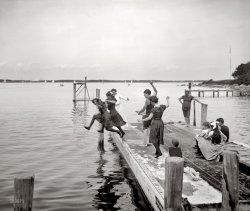
- Learning Factory: 1930
- ... to renovate this building and sell it (as a possible hotel), to the chagrin of much of the DC community and shelter residents. ... Posted by Dave - 09/04/2012 - 2:44pm -
![Learning Factory: 1930 Washington circa 1930. "Franklin School building exterior, 13th Street N.W." National Photo Company Collection safety film negative. View full size.
Frankin School NowDesigned by famed architect Adolf Cluss: more info
Washington Post Jun 26, 1992
Time Capsules
Experimental School
Southeast Corner of 13th and K streets NW
Completion of the Franklin School by architect Adolph Cluss in 1869 signaled a new city commitment to education reform. Building the modern 15 room school required every cent in the school construction budget for four years. The building was used as an elementary school until 1925 and as a D.C. school administration offices from 1928 to 1968. The city government continues to use the building.
Experimenting with his invention called the "photophone," Alexander Graham Bell transmitted sound on a light beam between the school and his laboratory on L Street NW in 1876. The invention was never a commercial success.
View Larger Map
Franklin shelterUntil very recently (last month), the Franklin School was used as a shelter for the homeless in DC. It housed about 300 men that often spent time in the park nearby. For some time, the DC government was seeking to renovate this building and sell it (as a possible hotel), to the chagrin of much of the DC community and shelter residents. http://www.washingtonpost.com/wp-dyn/content/article/2008/09/26/AR200809...
The Franklin School is in definite need of renovations. There are many boarded up windows and doors. The Google photo captured people at the door of the shelter above, probably when it was still used as a shelter. You can also see the huge pipes coming out of the windows to the right of the photo that were part of the initial renovation process.
The DuctsThe ducts coming out of the building in the Google photo are for air conditioning. Earlier, a man had died in the shelter when it got too hot.
Round Peg: Square HoleHey, just cause I'm a square doesn't necessarily mean I'm a guy. Hey Dave, when are you going to add a dating board to Shorpy?
[Shorpy, being a dead person, doesn't believe in social networking, long walks on the beach, quiet nights at home or any of that. And Stanton Square, I always thought you were a place. - Dave]
Once againI must say I've come to depend on Stanton Square for in-depth information on so many photos. And unlike so much in this world today, he never lets me down! Say, Stanton, are you married??
Mild-Mannered Reporter or Superhero?No matter what Stanton Square may be up to in her or his private life, all those wonderful informational posts on these pages lead many of us to think of S-S as an Institution.
Franklin School MinaretsPost-Civil War architects were certainly free-wheeling in some of their design choices, and many buildings of this period combine unexpectedly internationalist features. The Second Empire French mansard roof on the core block of the school is a commonplace of high-style buildings designed in the 1860s. What's more intriguing are the four Mughal Indian-style minarets and matching arched cornices, that give the facade its muscular visual stability. Several international design references published in this period, such as Owen Jones's Grammar of Ornament, were eagerly purchased and used by major American architects to enrich their vocabulary of quotable motifs, and their adventurous mix-and-match choices are part of the enduring appeal of their buildings.
Washington Street View!Oh Stanton_Squared! Your post just alerted me to the fact that Google FINALLY has streetview for Washington, D.C. Oh, happy day!
Imposing perspectiveWhat sort of camera/lens arrangement causes the odd perspective where the building seems to be bigger at the top than at the bottom, even though the top is farther from the street level view of the camera?
[The view cameras used to make these pictures had tilt-shift lenses, which allow for perspective correction. The building might look wider at the top because of the shadows from the cornice, which make the facade along the minarets seem to tilt out. - Dave]
+80As noted previously, the Franklin School building is still standing on the corner of 13th and K Streets, NW. Interestingly, the tops of central towers were both raised after the building's initial construction. In addition, a more elaborate roof replaced the original one (which may have resulted in the loss of the bust that can be seen on the front ledge in the older view). Below is the same view from April of 2010.
(The Gallery, D.C., Education, Schools, Natl Photo)](https://www.shorpy.com/files/images/31054u.thumbnail.jpg)
- What Goes Up: 1907
- Detroit, 1907. "Hotel Pontchartrain under construction." The 10-story, 298-room "Pontch," after ... The Pontch was built just before several changes to the hotel industry - bathrooms for each hotel room, early air conditioning, etc. That was a big contributor to its ... Posted by Dave - 03/31/2017 - 12:20pm -
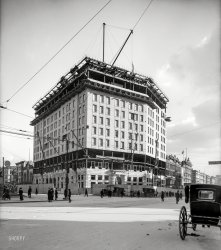
- Over Omaha: 1938
- ... school at 1302 Douglas Street, because I found the Arcade Hotel at 1215 Douglas (reference: https://history.nebraska.gov/collections/arcade-hotel-omaha-neb-rg3870am ). Since hlupak604 identified the Ford Bros. Van ... Posted by Dave - 06/24/2019 - 12:59pm -
![Over Omaha: 1938 November 1938. "Omaha, Nebraska." A bird's-eye view of, among other attractions, Tri-City Barber College. Photo by John Vachon for the Farm Security Administration. View full size.
Found one!The Ford Bros. building (in the upper right corner of the photo) still stands at the corner of Dodge & 11th streets.
Graybar Electrical SupplyContinues to thrive all over North America, and is still employee-owned.
An early Ford spottedOne of the billboards advertises the film "Submarine Patrol," which was directed by John Ford for 20th Century Fox, the last Ford-directed film before a run of seven box-office or critical successes in a three-year period that would make him a legend.
Much Has ChangedMy 1940 Omaha City Directory places the barber school at 1302 Douglas Street. Virtually everything in this photo is now gone.
Much Has Changed IndeedI'm glad EADG found the barber school at 1302 Douglas Street, because I found the Arcade Hotel at 1215 Douglas (reference: https://history.nebraska.gov/collections/arcade-hotel-omaha-neb-rg3870am). Since hlupak604 identified the Ford Bros. Van & Storage building still standing at Dodge and N 11th Streets that means this photo is looking north towards what is now Interstate Highway 480. The railroad tracks in this 1938 photo, almost every building, and the tall building from which this photo was taken (and is casting the shadow) are gone.
Yes pleaseSunshine Biscuits! Yay! I'll have a case of Hydrox cookies. And a visit to the Uptown Cafe too, after parking under cover for only 20 cents. Just sounds like a great time. What a fabulous picture. I scanned it for many minutes, as big as I could get it. This is why I love Shorpy: unvarnished but soulful glimpses of long-ago America.
It took me awhile to find oneDoesn't look like they had too many trees in the area back then
Strange place for a periodThe A.Y. McDonald Mfg. Co. has a period under the c in McDonald. I'm what is considered an old timer, and I had never seen this before today.
[Those glyphs (dots, triangles, dashes, etc.) under superscript letters are diacritics. - Dave]
Identity Theft?It is interesting to note that this 1938 scene includes a billboard touting the presumably-yet-to-be-released 1939 Chevrolet by means of an illustration that bears very little resemblance to the actual design. Could this have been an early version of fake news?
[As most everyone knows, Detroit’s model year begins in the fall or summer of the previous calendar year. And that is a faithful rendering of the 1939 Chevrolet. -Dave]
The '39 Chevy had a V-section grille, receding at the top, with a center strip. The illustration suggests a more LaSalle-like vertical curved prow -- reason to believe that the illustrators were working from a prototype or sketch of same.
[You're mistaken. And the photo is from November 1938. - Dave]
A.Y. McDonald Mfg. Co.An immigrant from Scotland, born in 1834, A. Y. McDonald opened his plumbing shop in Dubuque, Iowa, in 1856, making his company nowadays, at 163 years old, one of the country’s 100 oldest family businesses. It expanded to Omaha in 1915. The firm’s president is still a McDonald, great-great-grandson of the founder. A.Y. himself was in the Civil War, shot twice, and he was shot a third time, later in life, in a home invasion. He died in 1891 at the age of 57.
What a fascinating photo that rewards multiple and extended viewings. It all seems to be gone, as EADG points out, but if you google 1150 Douglas Street, outside the photo to the right, to the east of the Omaha Stove Repair Works (1206-8 Douglas), you can streetview a few old survivors, notably a three-story red-brick building marked Specht.
OopsHey, Dave, you're right! It appears that the photos I googled, in an attempt to make sure I knew what I was talking about, illustrate 1940 models. Now, as a kid I'd never have been fooled in that way. Thanks for engaging on this one!!!
Graybar Electrical Supply... has a fascinating story. "Gray" is Elisha Gray, the (alleged) inventor of the telephone, whose patent was scooped by Alexander Graham Bell. The company was spun off from Western Electric, the wholly-owned supplier to the Bell System.
https://en.wikipedia.org/wiki/Graybar
(The Gallery, John Vachon, Omaha)](https://www.shorpy.com/files/images/SHORPY-8b14209a.thumbnail.jpg)
- Over the River: 1909
- ... cotta, which was used for such landmarks as the Ansonia Hotel and Carnegie Hall.
To the Island Below
From the time the ... Posted by Dave - 07/18/2012 - 6:57pm -
![Over the River: 1909 New York circa 1909. "East River and Blackwell's Island Bridge," a.k.a. the Queensboro Bridge or the 59th Street Bridge, around the time of its completion. 8x10 inch dry plate glass negative, Detroit Publishing Company. View full size.
SinisterWow. Bridge into Mordor, right?
Look!Midspan on the lower level, a trolley is heading towards Queens on what today is the outer roadway to Queens.
New York Architectural Terra Cotta Co.From 1886 to 1928 this was one of the leading manufacturers of terra cotta, which was used for such landmarks as the Ansonia Hotel and Carnegie Hall.
To the Island Below
From the time the bridge opened until the mid-1950s trolley cars operated over the bridge. For much of this time the service included a stop in the middle of the bridge to access a ramp to an adjacent building containing elevators that could transport passengers down to the island below, which was by then called Welfare Island (now known as Roosevelt Island).
Between 1930 and 1955 elevators for motor vehicle access to the island were also operated, via a ramp from the bridge to this building. The island then contained a number of hospitals and some jail facilities, and the elevators were the only public access route until a direct bridge from Queens was built in 1955.
Feelin'Groooovy.
+95Below is the same view from August of 2004 (previously seen in a very similar view here: https://www.shorpy.com/Queensboro-Bridge)
Which wayWhat direction are we looking in? East? I lived near the bridge in what's called the Projects on Vernon Boulevard. As a kid I used to take the trolley with my parents to Manhattan to attend church on Second Avenue and 69th Street.
[The building shown is on Vernon Boulevard in Queens. So this is looking east. - Dave]
Queensbridge and the Trolley Swan SongQueensbridge projects went up 30 years later. It's hard to get your bearings on the photo. It flattens things and Blackwell's Island blocks our view of the rest of the river.
In foreground: West Channel of East River. Three of the bridge's four steel towers are visible. The East Channel is not; it is as wide as the span between the second and third tower. The masonry pier of the third tower marks the Long Island City shoreline. In front of it is the Blackwell's Island warden's mansion.
Beyond the third tower is the last of the bridge truss work, ending at a fourth pier sitting on the Queensbridge side of Vernon Boulevard. The domed masonry tower rising along side the bridge is part of the fourth pier. It has a twin - obscured here - on the north side of the pier. Each tower has a doorway downstairs on the sidewalk. The projects cover a lot of ground, and if Vernon was closer to your apartment than Queens Plaza, you could enter a doorway and take the elevator up to the trolley.
It's tough to picture where the projects would later be, but it can be done. Through the archway of the second tower you see a row of three-story buildings. They are on the east side of Vernon, across the street from our south "elevator tower". The spot marks the southwest corner of the projects.
In front of the buildings you see a wooded area lying on the river side of Vernon. Follow it to the left past the archway, to the arched pier of the first tower (note the boat's sail in the East Channel), past the pier to the house lying in sunshine. The house and the telephone poles along the stretch are on Blackwell's Island. Here the woods on the far side end, and across Vernon marks the northwest corner of the projects.
The wooded area became a park in 1935 - today's Queensbridge Park. Many a "home" game was played here, with "road" games a trolley ride away at the field hugging the bridge on the Manhattan side.
April, 1957 was the trolley's last trip, concluding the streetcar age for the city and the state. Take the trip:
(The Gallery, Boats & Bridges, DPC, NYC)](https://www.shorpy.com/files/images/4a19977a.thumbnail.jpg)
- The Clarendon: 1905
- Daytona Beach circa 1905. "The Clarendon Hotel -- Seabreeze, Florida." 8x10 inch dry plate glass negative, Detroit ... View full size.
The Clarendon today This hotel is now the Plaza Resort and Spa...I think I liked it better in the old ... four years after this photograph was taken, the Clarendon Hotel in Seabreeze (now Daytona Beach) was destroyed by fire . Two years ... Posted by Dave - 08/13/2012 - 6:57pm -
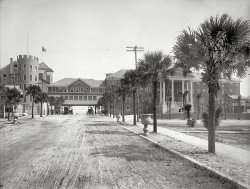
- Hello Columbus: 1909
- ... taken looking north from the roof of the Great Southern Hotel (seen here https://www.shorpy.com/node/9133 ) at the corner of East ... been taken from the Courthouse, the Great Southern Hotel would be visible from this angle. - tterrace]
Theo Wolfram Co. ... Posted by Dave - 10/07/2012 - 11:24pm -
![Hello Columbus: 1909 Columbus, Ohio, circa 1909. "Aerial view from courthouse." Shorpy, who knows how to have a good time, is celebrating Columbus Day with this detailed panorama made from three 8x10 glass negatives. View full size.
The Trolley FolliesLooks like Columbus is celebrating Columbus Day with Streetcars on Parade.
Then and nowI love these detailed panoramas. Most of the fun (after absorbing the detail) is trying to match them to the Google streetview equivalents. Assuming this is looking north (based on shadows) and using the address on Stewart Brothers store, would this same view would now be looking at the Greater Columbus Convention Centre?
Re: Then and nowThe convention center would actually be farther to the north, out of view in this picture. The tall two-toned building near the upper center of the photo is still there today.
Happy Columbus DayDelightful shot of my city, including the distinctive Statehouse rotunda.
Big Al42--This would be well south of the current convention center--about 12 blocks south. It looks north on High Street, from about Mound Street.
Dad Entered OSU in 1909My father entered the engineering school of OSU in 1909, graduated in 1913.
He had stories that the streetcars were short affairs with just a single solidly mounted 4-wheel truck. There was so much overhang that the naughty university boys could time their jumping at each end and cause the car to (nearly??) leave the track.
From East Main and South HighI believe this is photograph was taken looking north from the roof of the Great Southern Hotel (seen here https://www.shorpy.com/node/9133) at the corner of East Main Street and South High Street. At least two buildings are still extant on the west side of High Street with another that may have an updated façade. In addition to the Capitol rotunda noted by srich12345 in the center distance, the tall building at 8 East Broad Street is visible (also seen here https://www.shorpy.com/node/8661 and still extant). The view toward this vantage point looking south down South High Street from State Street can be seen here https://www.shorpy.com/node/8652.
[Good catch. If this had actually been taken from the Courthouse, the Great Southern Hotel would be visible from this angle. - tterrace]
Theo Wolfram Co.Patented the Aluminum fretboard guitar in 1893 and was only in business another year or so after this photo was taken. I love these slices of life from a century ago, you never know what you'll see and learn.
http://19thcenturyguitar.com/index.php?option=com_content&view=article&i...
(Panoramas, DPC, Streetcars)](https://www.shorpy.com/files/images/SHORPY_Columbus_Panorama.thumbnail.jpg)
- The Chalfonte: 1913
- Atlantic City, New Jersey, circa 1913. "Chalfonte Hotel." 8x10 inch dry plate glass negative, Detroit Publishing Company. View ... Posted by Dave - 08/14/2012 - 12:54pm -
![The Chalfonte: 1913 Atlantic City, New Jersey, circa 1913. "Chalfonte Hotel." 8x10 inch dry plate glass negative, Detroit Publishing Company. View full size.
Duntley PneumaticThere are the ubiquitous Salt Water Taffy, and the familiar Welch's Grape Juice, but I had to look up the Duntley Pneumatic Cleaner.
This thing makes the old Kirby Classic we had look like a featherweight!
Today's beachwearA couple of days ago, I saw several topless women sunbathing on Miami Beach. Topless women is a common sight on the beach there. I am curious what the people in this 1913 beach scene would think about what I saw on Miami Beach and I did not give it a second thought.
Pregnant woman at the beach.There appears to be a young woman "in a family way" standing at the edge of the surf with her hands behind her back. I do not recall seeing another expecting mother in a beach crowd from Shorpy's turn of the century archives.
[That's a man, and probably not preggers. - Dave]
Corsets optionalAll over the world "clothing optional" beaches are gaining in popularity and people are willing to put it all out there in little or nothing. I marvel at the huge quantity of clothing most of these people wore to the beach including hats, coats, jackets, umbrellas, boots, belts, corsets, etc. and here we are one hundred years later wondering "what were they thinking?" If they could come back and judge us in speedos and thongs, what do you think they would say?
Must be a disposable.I've lived near the Atlantic my whole life and I'm not sure I've ever seen anybody canoeing it.
Corsets, etc.If they could come back and judge us in speedos and thongs, what do you think they would say?
I suspect they would envy us our lack of scratchy and heavy bathing wear, as well appreciate the invention of sunblock, flip flops and beach towels.
ChalfonteHuh -- my family is from Chalfont, Pennsylvania.
I had a friend years ago who said it sounded like one of those diseases people don't catch anymore.
Pre-CoppertoneThe clothing in these old beach pics reminds us that a deep tan was not always cool. At the turn of the century only common laborers had a tan, and true ladies and gentlemen avoided said tan at all cost. Of course I'm not telling you Shorpters anything you don't already know. That's why you're Shorpsters.
Aunt KateMy great-aunt Kate Devon worked at the Chalfonte in the very early 1900s as a maid. Later as a manager of the linen closet operation. She also did calligraphy for fancy weddings and dinners that were held there. She apparently made good wages or otherwise got tips or other favors, as she vacationed in Florida during the winter.
WaxworksMy mom took my sisters and myself to the Chalfonte in August 1971. It was still very elegant but one got the sense that time had already passed the place by. My strongest memory is one of the old matrons that spent her summer at the Chalfonte expressing her displeasure that my mom was taking us kids out to the amusements after 8 pm!
(The Gallery, Atlantic City, DPC, Swimming)](https://www.shorpy.com/files/images/4a19467a.thumbnail.jpg)
- Native Fishers: 1941
- ... what the falls looked before inundation. I get to the hotel, eat a meal, and check my email. And I see this photo. First, I thought, ... Posted by Dave - 02/05/2022 - 12:23pm -
![Native Fishers: 1941 September 1941. "Indians fishing for salmon at Celilo Falls, Oregon. At the present time Indians have by treaty exclusive right for fishing in Columbia River, which is adjacent to their reservation. This right is now being contested in lawsuits." Medium format acetate negative by Russell Lee for the Farm Security Administration. View full size.
About that footbridgeMy guess is that the Indians constructed it for the use of the folks contesting their exclusive right to fish.
No MoreSadly, these beautiful falls are now long gone; drowned by the building of the Dalles Dam.
A river runs through itThat’s a fantastic photo, just a hive of activity, with an exciting waterway and a dramatic backdrop. I see a fish in the big net on the right, and I think I see a guy up to his waist in the water, just left of the very center of the picture. Myself, I would feel somewhat precarious on those platforms, but no one has invited me along.
I think I see my manThe demurely-coifed lady in heels and hosiery and practical coat is certainly out of place, but she's got her eye on something. Or someone.
Medium formatI always wonder what size the negative is when it is 2x3 or 3 1/4x4 1/4 it would be interesting to know.
[4x3. - Dave]
What a Coincidence!Today I was driving West on I-84, along The Columbia River. I saw a sign for Celilo Falls. I looked out at the bloated river behind the Dalles dam. I wondered what the falls looked before inundation. I get to the hotel, eat a meal, and check my email. And I see this photo. First, I thought, what a great coincidence. But soon I was sad at the loss of a way of life and sustenance for the indigenous population.
Re: NativeI’m 63 and live in Canada, and the official word for Indigenous people has evolved over my lifetime, as follows: Indian, Native, Aboriginal, First Nations, Indigenous. (In French in Quebec it’s autochtone, “from the earth.”) I wonder what it will be next.
35 second newsreel footageEmbedded in the following Wikipedia entry is a 35 second newsreel footage of this very scene, taken in 1956.
https://en.wikipedia.org/wiki/Celilo_Falls
(The Gallery, Landscapes, Native Americans, Russell Lee)](https://www.shorpy.com/files/images/SHORPY-8c22358a.thumbnail.jpg)
- The Bear Pits: 1910
- ... isn't the Gayoso!
Poor bears. Instead of the fancy hotel, they get an iron cage with some rocks and a tree stump. The solemn ... Posted by Dave - 09/14/2011 - 12:04am -
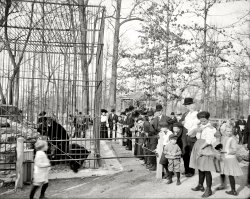
- The Palace: 1920
- ... "Market Street, San Francisco, 1920." Starring the Palace Hotel and, rising behind, the Call Building. 8x10 glass negative. photographer ... My husband and I were able to enjoy this grande dame hotel on a recent visit, and the interior spaces are as beautiful the ... Posted by Dave - 05/03/2016 - 1:05pm -
![The Palace: 1920 "Market Street, San Francisco, 1920." Starring the Palace Hotel and, rising behind, the Call Building. 8x10 glass negative. photographer unknown. View full size.
What is writtenon the sidewalk at the bottom right.
[CROCKER SAFE DEPOSIT VAULTS. Camouflaged as manholes. - Dave]
What's up?Those are the tallest street lights/lamps I have ever seen. Can't imagine the purpose of putting them that high up, and maintenance must have been fun.
[They're still in use on Market Street, including at this very corner. -tterrace]
Street Lights.The reason the street lights are so high is they served dual purpose. If you look closely you can see where the catenary (trolley wire) is actually attached to them. This actually wasn't all that uncommon at one time, since it allowed the city to have its public transit system, and to hide the (usually) unsightly support poles. What's more, it also meant that you didn't have to clutter things up with a second set of poles for the lights themselves.
Gorgeous Inside and Out!My husband and I were able to enjoy this grande dame hotel on a recent visit, and the interior spaces are as beautiful the streetscape. The Garden Court is an amazing space, I only wish we'd been there during the day to see the stained glass skylights.
"The Roar of the Four"The title is in reference to the constant stream of streetcars during the era of competition between the Municipal Railway and the Market Street Railway. Today the Muni has two surface tracks as well as two subterranean tracks at this location. Below them BART has its too tracks. Roar of the Six?
Let There Be LightsThose extra-tall streetlights are actually historic landmarks, specifically "San Francisco Landmark #200 Path of Gold Light Standards." They're part of the City Beautiful movement of the early 1900s, meant to illuminate San Francisco's then-primary artery Market Street.
Initially installed in 1916, the poles' bases were designed by famed West Coast architect WIllis Polk and feature bas relief images of covered wagons, mountain lions, and alternating prospectors and Native Americans.
For more info on Path of Gold check out this page.
(The Gallery, Cars, Trucks, Buses, San Francisco, Streetcars)](https://www.shorpy.com/files/images/SHORPY-963.thumbnail.jpg)
- Granby Street: 1905
- ... torn just down just a year or two ago, to make way for a hotel. The cross street is Main.
When I gain those ruby slippers... my ... Posted by Dave - 08/25/2012 - 4:58pm -
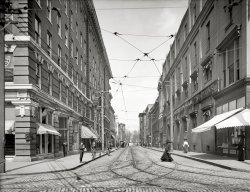
- Let Me Out: 1920
- ... building was razed in 1928 to make way for the Ambassador Hotel.
Washington Post, Oct 5, 1913
Will Remodel 2 ... Posted by Dave - 07/08/2014 - 1:00pm -

- No Lions Yet: 1908
- ... bottled water wagon passing the former reservoir site. The hotel Albany smack in the middle of what would become Bryant (as in William ... Posted by Dave - 08/01/2012 - 5:47pm -
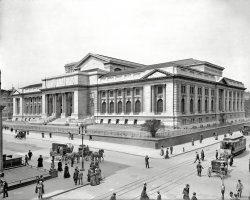
- The Oceanside: 1910
- ... days.
The Oceanside The Oceanside was a popular hotel. Unfortunately it burned down.
Whistling or more likely biting her ... Posted by Dave - 08/09/2012 - 2:42pm -

- The Artsy Hearth: 1906
- ... spring water dispenser for the convenience of the hotel guests. The little sink below has a glass tumbler, and the legible words ... Posted by Dave - 07/29/2012 - 1:32pm -
![The Artsy Hearth: 1906 Crawford Notch, New Hampshire, circa 1906. "Fireplace, Crawford House." 8x10 inch dry plate glass negative, Detroit Publishing Company. View full size.
Great ExpectorationsThe spittoon behind the rocker on the right is decidedly cleaner than others we have seen recently.
Don't forget your keys!So there's a key in the kinda-sorta keystone of the fireplace, and a Greek key meander pattern in the hearth rug. Coincidence, or are the furnishings nagging me, again?
What the heck is that light?What in tarnation is that light fixture? It can't be electric; it has a chimney. Is it gas? Why are there two control chains?
Also note the key in the key-stone. I think it's an example of early 20th-century brick-laying humor.
[The chains are for gas on and gas off. And I guess more gas/less gas. - Dave]
Odd place for a sinkTo the right of the fireplace.
Hearth HygieneSo what's with the sink and soap dispenser to the right? It looks like they cut out a part of the wall later and added a sink. Is this a room or the lobby?
I came for the waters.At first I thought that the strange little alcove to the right of the fireplace was a lavabo for hand washing, such as one might find in a corner of a 19th Century commercial dining room. But, no. The LOC's highest resolution scan adds a bit more clarity to the wheel-cut lettering on the globe, and it appears that this is a "brand-name" spring water dispenser for the convenience of the hotel guests. The little sink below has a glass tumbler, and the legible words on the globe are "Spring Water." I can't quite make out the proper name, though. Not Lithia and not Poland. Perhaps Merritt?
Sit Down and Stay AwhileMaybe I'm crazy, but this scene looks pretty inviting to this Southern boy, especially if I was up in New Hampshire on a cold winter day and this fireplace was serving its purpose. I love the intricacies of the masonry, the wallpaper, the decorations. I'm guessing a colorized version of this photo would be amazing.
Lady of the ManorI am guessing the ghostly image behind the chair on the right is the lady of the house hovering. I wish they would try to get the wrinkles out of that carpet.
Wonderful piece of (my!) historyMy great-great-grandfather Asa Barron bought Crawford House in the 1870s. I've never seen any interior photos before now! Thanks so much for putting it up.
The LadyThe lady at the edge of the frame has a quality that is almost like a portrait to the point where I wonder if it might indeed be a painting.
The fireplace was there until the endSome photos of the abandoned Crawford House taken in 1977. The fireplace can still be seen in one of them. Shortly after the building was destroyed by fire.
(The Gallery, DPC)](https://www.shorpy.com/files/images/4a22047a.thumbnail.jpg)
- Clock Golf: 1905
- Miami circa 1905. "Clock golf at the Royal Palm Hotel." 8x10 inch dry plate glass negative, Detroit Publishing Company. View ... Posted by Dave - 07/19/2012 - 1:00pm -
![Clock Golf: 1905 Miami circa 1905. "Clock golf at the Royal Palm Hotel." 8x10 inch dry plate glass negative, Detroit Publishing Company. View full size.
All sand trap, no greenMy mother had clock golf set up in her back yard, as a child. Not as big, perhaps but it was all green.
Clock Golfhttp://www.clockgolfpro.com/home/clockgolf
Away from the farmThe couple in the forground appear to be a younger Ma (Phoebe) and Pa Kettle on holiday away from the farm. Yep, Marjorie Main giving it to Percy Kilbride for complaining about not being able to wear his bib overalls to breakfast.
PuttingMust have been very tough to putt on compacted dirt, right? Simply awful.
Just viewing this image - I can sense the heat of day, especially dressed head to toe in wool.
The heatWhen ever I see these pics of Florida, I wonder how they could take the heat and humidity with all those clothes on.
[This would have been in winter, when people vacationed in Florida. - tterrace]
Surface groomer thingyLooks like the lad at the right is dragging a large flat surface groomer thingy (like what they use on baseball infields) around the putting area to smooth out the surface.
Madames MillineryWhen milliner was a profession.
Croquet And the gentlemen in the background seem to be playing the Queen of Games: croquet.
(The Gallery, DPC, Florida, Miami, Sports)](https://www.shorpy.com/files/images/SHORPY_4a12564a.thumbnail.jpg)
- No Left Turn: 1948
- ... before long, such as expensive condominiums or a boutique hotel. Come to think of it, when the city agency leases in the Center Building ... Posted by Dave - 06/30/2013 - 12:18pm -
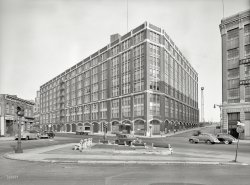
- Sand Castles: 1905
- The Jersey Shore circa 1905. "Marlborough-Blenheim Hotel, Atlantic City." 8x10 inch dry plate glass negative, Detroit Publishing ...
What replaced it That fabulous Marlborough-Blenheim Hotel was ultimately torn down in 1979 and replaced by this mundane-looking, ... Posted by Dave - 03/03/2013 - 1:00pm -
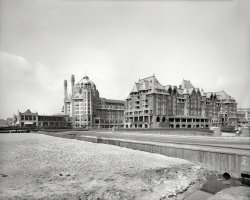
- Truck Amok: 1958
- ... In that case, the pole lost. It fell over and the nearby hotel went pitch black. The car didn't have a scratch. I still have it and ... Posted by Dave - 08/03/2015 - 5:24pm -
![Truck Amok: 1958 Oakland, California, circa 1958. "Wrecked Autocar reefer." Latest entry in the Shorpy Archive of Motor Mayhem. 4x5 acetate negative. View full size.
Quite an impact!Wonder if the driver survived the accident.
Hope the driver survivedMy father's sister, the last survivor of ten kids, rolled an 18-wheeler two and a half times about the year of picture. (She was a full-time housewife and mother of five kids, and a part-time trucker, but never wore Army boots.) As a result of the accident, she had one leg two inches shorter than the other--until about five years ago when she got a replacement knee and hip and they evened 'em up. For the first time in my whole life I got to see her walk level at the age of 82.
I wish I had a picture to post here of the '56 Pontiac my parents used to challenge a telephone pole on New Year's Eve 1960. The pole won that one, too. Which was fine by me as I hated that car, only slightly more than the '59 Starfire that replaced it.
(I have to confess, when I was 15 and leaving my after-school job, I backed into a telephone pole with my '65 Cadillac. In that case, the pole lost. It fell over and the nearby hotel went pitch black. The car didn't have a scratch. I still have it and polished that still-perfect bumper just a few weeks ago.)
To quote Chris Elliott in Groundhog Day ...He might be okay.
Well, probably not now.
YEOW!!!That takes the prize as being the worst wreck so far in this Shorpy Archive of Motor Mayhem series.
I can't imagine the driver surviving this, and adios if some poor soul happened to be walking on the sidewalk when that trailer tipped over.
I'll be doing 25 mph on the DC Beltway for tomorrow morning's commute.
Reefer MadnessDespite having several family members in the trucking industry, including my father and uncle, I had NEVER heard the term reefer (at least not pertaining to refrigerated trailers...wink wink). I learn something new regularly thanks to Shorpy.
StrengthThey must have pretty strong utility poles in Oakland to put up with the abuse I've seen in Shorpy lately.
[After having scanned dozens of these negatives over the past few days, I can attest that cars would be a lot safer if they were made of telephone poles and lampposts. - Dave]
ThermoKingThe diesel driven cooling plant for reefer trailers invented and built next door to me in Saint Paul, Minnesota.
This crash doesn't look good.
Bad accidentAnd yet I can't stop wondering about 'red front' with the upside down 'der' on the auction house in the background.
TantalizingThis picture almost gives me enough information to identify the situation, but not quite. The trucking company's logo on the driver side door is obscured, the location is unremarkable and the exact date is unavailable. Hopefully some west coast Shorpy readers can shed some light on the story.
Re: StrengthDave, your parenthetical is akin to the comment by one comedian who suggested aircraft be made entirely of the same material as those indestructible "Black Boxes". Fascinating.
Lucky MaybeAt least it was not a wood cab A-Car (AutoCar). There were still a lot of them still in use in the Midwest in 1958. I was working at a truck stop then as a pump jockey and tire man. There were several drivers with the wood cabs that made regular stops for fuel and food.
David Fry
(The Gallery, Cars, Trucks, Buses, Signal 30)](https://www.shorpy.com/files/images/SHORPY-442-01A.thumbnail.jpg)
- Worthington and Main: 1908
- Springfield, Mass., circa 1908. "Worthy Hotel, Worthington and Main Sts." Dozens of errands frozen in time on this ... Posted by Dave - 02/04/2013 - 12:35pm -
![Worthington and Main: 1908 Springfield, Mass., circa 1908. "Worthy Hotel, Worthington and Main Sts." Dozens of errands frozen in time on this 8x10 glass negative. View full size.
A mosque, or Zag-A-Zig ?Curious what the Byzantine-like structure in the background is.
Now an Apartment BuildingLooks like the Worthy as well as the building two doors down are still there!
1:38 In the afternoonWonder what the two men in the foreground are talking about? So much daily life to see. I always wonder, what did they do when they got home? Ever notice when you look at the same spot today on Google, there are not as many people out and about as there were then? Must be a mix of time of day, people were outdoors more and that all the stores were in the city -- they didn't have the suburban Walmart.
Still there!Along with a few others, from Google Streetview:
http://goo.gl/maps/wKoQo
Urban mass transit!What we need more of today - I count seven streetcars in a single split-second exposure.
Love these Springfield PicturesIt's fun for me to see a couple of pictures of Springfield posted today. I grew up there in the 1950s/early 1960s and many of those great old buildings still survived then. It surely wasn't quite like the scenes portrayed here, but it was closer than today, after extensive "urban renewal", which I consider merely "urban destruction".
The onion-domed building on the left in this picture can be seen from the other direction on Main Street in a 2009 post on Shorpy: https://www.shorpy.com/node/5442
Not a mosqueI think it says "Lewis House."
[JOHNSON'S BOOKSTORE. - Dave]
Year of photoThe license plate on the car in the photo was issued in 1906 and expired at the end of 1907 so the photo was taken sometime in that two year period rather than in 1908.
Canopies/AwningsWhat strikes me about this photo is the number of huge canopies over the windows. I suppose that in an age without A/C, keeping the place cool was best done by keeping the place shaded. There are even partially retracted ones on the "mosque" building. When did they go out of fashion, I wonder?
[More generally known as "awnings." - tterrace]
Yes, I realized that after posting.
Onions On TopThe extravagantly topped building is the Fuller Building, also known as the Fuller Block. Built in 1887 at a cost of $125,000 it included passenger elevators, steam heat, mail chute, and running water in each suite of rooms. It boasted Georgean marble floors, marble staircaise, as well as marble wainscoting. Attracted many prominent tenants and businesses. At the time it was one of the largest and finest commercial office buildings in Springfield. It was renovated in 1986.
Onions? More like icing I wonder if there's any rhyme or reason to the choice of "toppers" on the roof of the Fuller building - DRoy, you seem to know about this building, care to comment? Did they just think them pretty or do they serve some some purpose?
"The mosque"It even has a crescent moon on top. I would love info on the architects and original builders.
[Interestingly, Googling Fuller Block Springfield Mass. turned up a number of hits, including this one. -tterrace]
(The Gallery, DPC, Streetcars)](https://www.shorpy.com/files/images/SHORPY_4a22730a.thumbnail.jpg)
- Potatoe Cakes: 1927
- ... D.C., circa 1927. "E.B. Adams Co. -- Cafeteria, All States Hotel for Women." 8x10 inch glass negative, National Photo Company Collection. ... West End's historic designation nomination, the All States Hotel for Women at 514 19th Street NW was constructed in anticipation of the ... Posted by Dave - 07/07/2019 - 2:20pm -
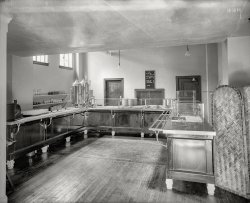
- Small Curd: 1924
- ... Farms Dairy's estate was positively palatial. That's a hotel.
[These are rowhouses. The caption note "Chestnut Dairy" means the ... Posted by Dave - 09/13/2011 - 10:54am -
![Small Curd: 1924 Washington, D.C., 1924. "Chestnut Farms Dairy." ("Cottage cheese, sugar? Yes, honey.") National Photo Company Collection glass negative. View full size.
Are you going to eat that???It looks like she gets her fair share of calories. He, on the other hand, looks like he sticks to the cheese products.
Not a whole lot of lovin'Not a whole lot of lovin' going on with that cottage cheese breath.
Strange CompositionThe photographer seems more fascinated with the perspective of the porches receding to infinity than in the diary-focused dinner. The odd high table seems to contribute to this. Why not have a normal table height with the camera looking down on the scene?
[It's what happens when you're focusing on that diary. - Dave]
Pshaw on the rowhouse commentThe tunnel-of-doom effect is done with mirrors. It's the same optical illusion anyone sees in a fitting room with mirrors on opposite walls.
You don't see the "people" in the reflections because they're vampires.
Re: Brick TitanicI've often thought my porch and its environs resembled the Lusitania.
Dear DiaryLook again -- the table is normal height. It's the chairs that are low because they are intended for lounging, not dining. That is, if you wish to call tomatoes, cottage cheese and milk dining....
Brick TitanicIf it weren't for the fact that it's a dozen years too late and constructed out of material that wouldn't float very well, this could almost pass for the deck of the Titanic. Not sure if agri-tourism was around back then, but the Chestnut Farms Dairy's estate was positively palatial. That's a hotel.
[These are rowhouses. The caption note "Chestnut Dairy" means the dairy was the National Photo client who commissioned the picture. - Dave]
Plastic ContainerThe cottage cheese tub looks very similar to those plastic tubs you would find today. Wonder if it is made of tin or paper.
[Waxed paper. - Dave]
Pretty CoolI just got a new cordless mouse and, among other things, it has a magnifier as one of the four possible buttons, plus the wheel. Comes in handy for Shorpy's once in a while.
Dairy productsYou know, even during Prohibition, I don't think many people outside of dairy advertising drank milk out of wine goblets.
A tidy rowI love the pristine look of these new brick row houses. This photo reminds me of the 4700 block of 8th Street.
(The Gallery, D.C., Natl Photo)](https://www.shorpy.com/files/images/25898u.thumbnail.jpg)
- Vermont Country Store: 1959
- ... multi-storied wooden and balconied Tyler Place resort hotel, which I believe burned down in the early 60s.
Good memories of a kid ... Posted by Dave - 06/19/2015 - 10:40am -
![Vermont Country Store: 1959 August 1959. "Vermont Country Store, Weston Common, Windsor County, Vermont. Building dates to 1828. Typical early country store still serving its original function, but filled with more merchandise than it would have originally had and now a popular tourist attraction." Photo by Ned Goode for the Historical American Buildings Survey, National Park Service. View full size.
Here's The ScoopI wonder if the Wilson Ice Cream brand was replaced with Ben & Jerry's which is made a mere 90 miles away in Waterbury, Vt.
[The sign says Wilcox's, not Wilson's. The brand is still in business. -Dave]
Yeah, but it's still 90 miles away from Ben & Jerry's
Oh, the daysWhen you could put your foot on your car's bumper and lean all your weight on it without ruining it.
The Orton Family BusinessSeems the place has staying power.
Car IDsThe man has his foot resting on the bumper of a 1949 Chevy. In the back rear of the building is a 1954 Dodge.
Inscription ?I am curious to know what is inscribed on the cemetery-style stone marker ?
My Wife Wants OneThe tombstone reads "My Husband".
A kid in 1950s VermontWe used to vacation for a few weeks every summer in the late 50s when I was a kid at various rented cottages in Highgate Springs, Vermont, on Lake Champlain, just over the border from Quebec where we lived in Bedford, about 20 miles away.
The favorite country store to go for popsicles and snacks was across the two-lane highway through town from the original multi-storied wooden and balconied Tyler Place resort hotel, which I believe burned down in the early 60s.
Good memories of a kid in the summer in Vermont.
Still ThrivingThey've expanded to national catalog and internet sales as well. What better place for antifungal cream?
http://www.vermontcountrystore.com
Fun to see a vintage photo of the VT Country StoreI've shopped via mail/online from the Vermont Country Store for many years. It's great to see a vintage photo of the store here on Shorpy. Here's a past catalog showing the store on the cover:
Family DynamicsMy favourite part of this photograph has to be the family gathered near the car. Each person is demonstrating a great deal of personality in their respective poses and also each child is mirroring the body language or facial expression of one parent respectively. A fascinating glimpse at family dynamics.
(The Gallery, HABS, Kids, Stores & Markets)](https://www.shorpy.com/files/images/SHORPY-167295pu.thumbnail.jpg)
- Cityscape: 1917
- ... roof of interurban station." Landmarks here include the Hotel Pontchartrain, Ford Building and Dime Savings Bank. 8x10 inch glass ... be happening much.
Which is the Ford building? The hotel has a sign to identify it; thus I am assuming the other two skyscrapers ... Posted by Dave - 08/15/2012 - 4:14pm -
![Cityscape: 1917 Detroit circa 1917. "Looking northwest from roof of interurban station." Landmarks here include the Hotel Pontchartrain, Ford Building and Dime Savings Bank. 8x10 inch glass negative, Detroit Publishing Co. View full size.
Sans PeerThe Peerless Film Company, shown in the foreground, was a film distribution firm. Detroit was home to a dozen or more of these concerns. The old nitrate films were highly unstable and it was not uncommon for them to spontaneously burst into flames. That is why the distribution companies eventually built a single building to house their products. The Film Exchange Building still stands on the northern edge of downtown, and yes, it is built to withstand fires.
By the way, the Peerless address was 153 East Jefferson, placing it just where the current CAY building stands. That side street with the tailgated horse cart, is Bates.
Come across the RiverI just noticed the sign for the Windsor Races (just under the Lawrence Printing Company). If this is 1917 that probably makes it the late spring or summer which means that Detroit (and America) are finally in a war that the Canadians in Windsor have been fighting for three years. And if then is anything like today they'll be featuring harness racing while on the north side of the river (Detroit) they were running thoroughbreds, if they were running anything at all. In years past - and maybe this year - there might have been recruiting stations at or near the races, and if they got the occasional American that was fine with them. In 1917, with Americans being drafted and Canada about to impose conscription, I doubt that would be happening much.
Which is the Ford building?The hotel has a sign to identify it; thus I am assuming the other two skyscrapers are the bank and the Ford building (perhaps the one on the left?). In any event, I am surprised at the size of the building. To have such a building to house office workers, already built and in-use by 1917, when Ford had introduced the Model T only 9 years earlier, makes me wonder how many workers it took to manage the paperwork. Did Ford have more clerks than autoworkers?
[The Ford Building (also seen here) was built by the family that owned Edward Ford Plate Glass and had nothing to do with Ford cars or Ford Motor Co. - Dave]
[This is exactly why I will never qualify for Jeopardy! But who knew that Detroit had another industrialist named Ford?]
Clean roofsAs someone who spends a great deal of time on flat commercial roofs, it always amazes me how empty such roofs were in the era before air conditioning and wireless communications. And the chimney at the far left (next door to Peerless Film) is long overdue for re-pointing.
More landmarksThe Penobscot (now Annex), Hammond, Majestic, City Hall are all visible here.
It's interesting to see the Pontchartrain from an angle that doesn't just show the Woodward facade.
There appears to be a very impatient motorist tailgating a horse-drawn cart in the lower right. An early road hog.
(The Gallery, Detroit Photos, DPC)](https://www.shorpy.com/files/images/4a24889a.thumbnail.jpg)
- Checkout Time: 1906
- "Palace Hotel, Market Street, San Francisco." After the devastating earthquake and fire of April 1906, the hotel was razed to make way for the "New" Palace, which opened in 1909. 8x10 ... it in order to create a firebreak to protect the Palace Hotel.
Memory of the Earthquake When I was a child, our family had a ... Posted by Dave - 03/01/2017 - 11:22pm -
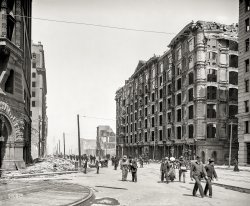
- The Colonial: 1901
- Circa 1901. "In the gardens -- Colonial Hotel, Nassau, Bahamas." Built by Henry M. Flagler on the site of Fort Nassau, the hotel was destroyed by fire in 1922. Its current incarnation is the British ... Posted by Dave - 09/07/2021 - 9:11am -
![The Colonial: 1901 Circa 1901. "In the gardens -- Colonial Hotel, Nassau, Bahamas." Built by Henry M. Flagler on the site of Fort Nassau, the hotel was destroyed by fire in 1922. Its current incarnation is the British Colonial Hilton Nassau, owned by the China State Construction Engineering Corporation. 5x7 inch glass negative, Detroit Photographic Company. View full size.
The Burn File It's been far too long since our last entry in the Hotels Which Burned To the Ground series. Beauties, every one of them, and this is certainly a worthy addition.
What has captured the gardener's attention, I wonder. He's just to the right of the "Bicycles" sign.
Does anyone know the name of the wheeled chair behind the three men, just in front of the stairs? It looks as if it might be the kind which could be guided by its occupant, using a center control bar.
[Not quite. - Dave]
Rabbit hole alertOne of the owners of the follow-on hotel, the British Colonial Hilton Nassau, was Harry Oakes. If you have an hour or four, search out his story. He was a gold miner turned tycoon that owned a big chunk of the Bahamas. He was also murdered in Nassau in 1943, and the murder has never been solved.
(The Gallery, Bicycles, DPC)](https://www.shorpy.com/files/images/SHORPY-4a27469a.thumbnail.jpg)
- Old Orchard Beach: 1904
- ...
Swimsuits to Let Love this photo of the beautiful hotel! Interesting to see that this photographer has captured another ... Posted by Dave - 08/14/2012 - 11:38am -
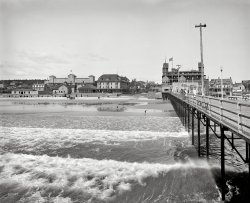
- Proceed With Caution: 1940
- ... I can count. The building on the right is the Wauregan Hotel, which dates to I believe 1855 (and, yes, Lincoln actually did sleep ... Posted by Dave - 06/04/2015 - 2:29pm -
![Proceed With Caution: 1940 November 1940. "Street scene on a rainy day in Norwich, Connecticut." Traffic Cop vs. Traffic Light. 35mm nitrate negative by Jack Delano. View full size.
I'm standing in the rain ...Well, working in the rain! These "rainy" photos are really exquisite.
SomethingSomething about this photo. One of the best I've seen on Shorpy ever.
Cop is gone, but --
Central casting...He looks like every Flatfoot in pretty much every 1940's Movie made.
Not much has changedI have driven through this intersection more times than I can count. The building on the right is the Wauregan Hotel, which dates to I believe 1855 (and, yes, Lincoln actually did sleep there). It was nearly demolished after falling into disrepair, but was saved. It was completely restored about 15 years ago and now has apartments. The building to the left housed banks for the last 120 years, but as of last year became vacant.
Norwich, like many manufacturing towns in New England, has struggled to find its way again after the businesses closed up shop.
CrosswalkI believe the crosswalk behind the officer is the same one Rainy Day Woman is using albeit the opposite direction as the woman in this photo. Curious which photo was taken first?
[It is the same crosswalk. -tterrace]
It's a reflection...of Delano's photographic artistry that he lined up the traffic cop's reflection as he did. And streets were so much slicker then.
Before the memo went outThat protective gear especially the type you wear while directing traffic in the middle of the street on a dark rainy day should be a bright color.
Why the Traffic Cop?Why does he need to direct traffic at an intersection controlled by traffic lights?
I can hear the musicBut where's Gene Kelly?
(The Gallery, Cars, Trucks, Buses, Jack Delano)](https://www.shorpy.com/files/images/SHORPY-8a34705a.thumbnail.jpg)























